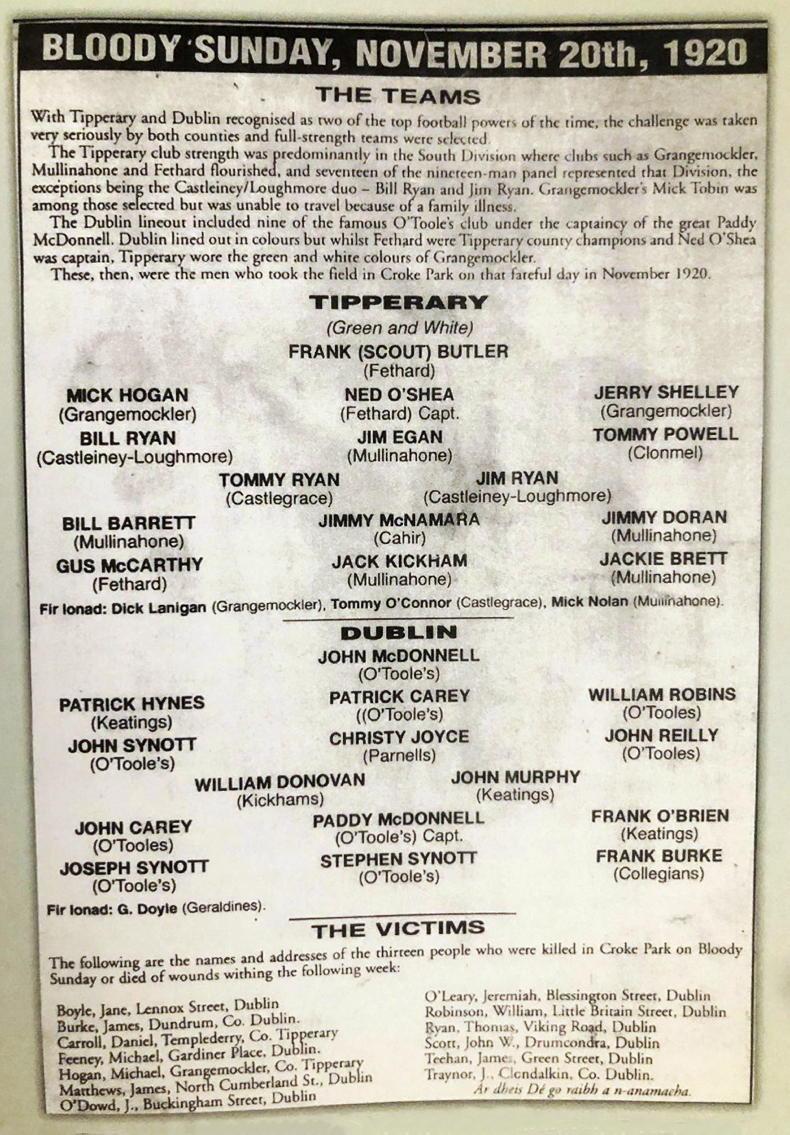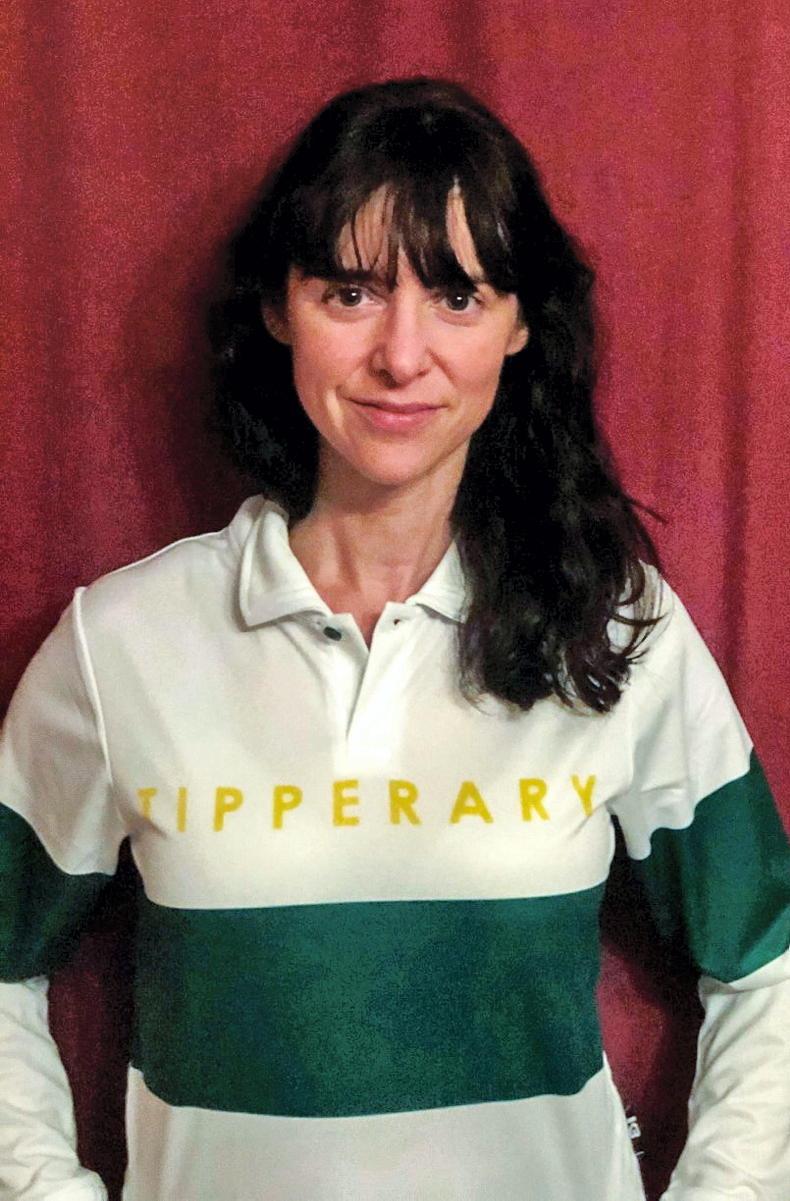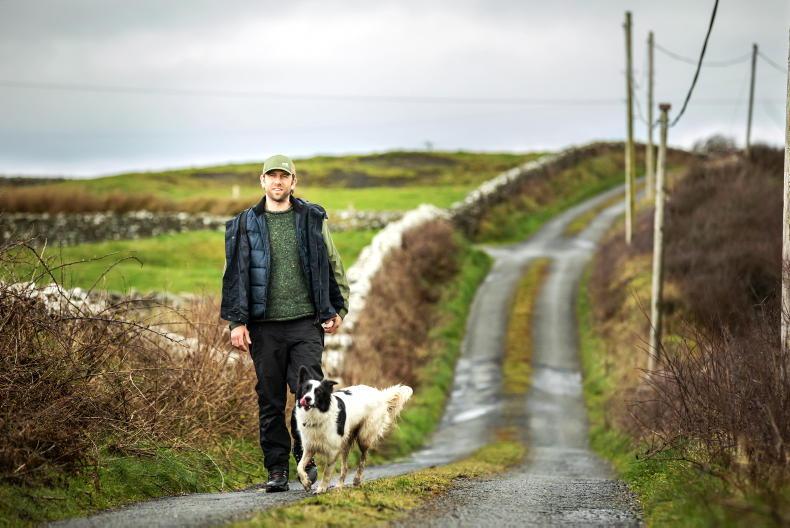A friend forwarded me a picture recently that she had seen on Facebook. The image was of the Mullinahone (Co Tipperary) team parading out before the 1946 south senior football final in Drangan. The caption on the post reads: “No stands, no dressing rooms, no nothing, no showers, only showers of rain, some men.” The reason it was sent to me is that my grandad, Walter Cahill, was second in the line-up striding out onto the pitch.

The person who sent the photo did not know that I was writing a story about Bloody Sunday. On that 1920 Tipperary team, the day that Mick Hogan was killed in Croke Park, there were five Mullinahone men named, as well as one sub from the small village. Grangemockler had another three named and one that could not travel. Most of these men were local farmers. While I have always been aware that Mick Hogan, of Hogan Stand fame, was from “over the road”, I didn’t really appreciate the legacy of this family until I wrote the piece. There will be a lot written this week about Bloody Sunday but I think that those that go to the effort of preserving those memories deserve some recognition too. Those, such as the two committees in Grangemockler, which have organised the Mick Hogan commemoration.
A few weeks into starting my role as editor of Irish Country Living, our sportswriter at the time, Emmet Moloney, got offered a new job opportunity and decided to move on. So, for a few weeks we had no sports page. We searched for a suitable replacement. Writing sport for a Thursday paper, when most of the commentary of what has happened has already been thrashed out or details are not fully available for the days ahead, is not the easiest job. During this interim period, before Denis started, I received correspondence which, upon reflection, was less of a polite enquiry and more admonishment. The reader cautioned that I was not to use Emmet’s departure as “an excuse to get rid of sport”.

The Tipperary team will play in the green and white Grangemockler jerseys when they play the Munster senior football final on Sunday 22 November 2020.
Sport is integral to this country with the GAA very much part of our history. In recent years, I have, to my shame, been more a fair weather supporter and now that I cannot go at all, I very much miss those occasions. My two little girls attend school in Poulacapple, which is a small school within the parish of Mullinahone. This is where Jim Egan was from. Jim who played centre back on 21 November 1920 and who fetched the priest to deliver the last rights to Mick Hogan. The same man survived Bloody Sunday but was killed in the last week of the Civil War in April 1923 in Poulacapple.
In sport, we had much to celebrate in 2019. The school won three county football championships, the under 13 boys and girls were both victorious and the under 11 boys came home as champions too. Quite an achievement for a school with a little over 50 students. So I think it is well deserved when last week our little school was one of the recipients of a €10,000 prize from the Aldi Play Rugby sticker competition (I appreciate that there is a slight irony in that). The prize, to be used to purchase sports equipment, will support the sporting dreams of our little future stars.

On Sunday 21 November 1920, Michael Hogan was shot and killed on the field of play in Croke Park.
I think Jim Egan and Mick Hogan from “over the road” will be looking down smiling and I can guarantee that sport won’t disappear from Irish Country Living in my tenure.
A friend forwarded me a picture recently that she had seen on Facebook. The image was of the Mullinahone (Co Tipperary) team parading out before the 1946 south senior football final in Drangan. The caption on the post reads: “No stands, no dressing rooms, no nothing, no showers, only showers of rain, some men.” The reason it was sent to me is that my grandad, Walter Cahill, was second in the line-up striding out onto the pitch.

The person who sent the photo did not know that I was writing a story about Bloody Sunday. On that 1920 Tipperary team, the day that Mick Hogan was killed in Croke Park, there were five Mullinahone men named, as well as one sub from the small village. Grangemockler had another three named and one that could not travel. Most of these men were local farmers. While I have always been aware that Mick Hogan, of Hogan Stand fame, was from “over the road”, I didn’t really appreciate the legacy of this family until I wrote the piece. There will be a lot written this week about Bloody Sunday but I think that those that go to the effort of preserving those memories deserve some recognition too. Those, such as the two committees in Grangemockler, which have organised the Mick Hogan commemoration.
A few weeks into starting my role as editor of Irish Country Living, our sportswriter at the time, Emmet Moloney, got offered a new job opportunity and decided to move on. So, for a few weeks we had no sports page. We searched for a suitable replacement. Writing sport for a Thursday paper, when most of the commentary of what has happened has already been thrashed out or details are not fully available for the days ahead, is not the easiest job. During this interim period, before Denis started, I received correspondence which, upon reflection, was less of a polite enquiry and more admonishment. The reader cautioned that I was not to use Emmet’s departure as “an excuse to get rid of sport”.

The Tipperary team will play in the green and white Grangemockler jerseys when they play the Munster senior football final on Sunday 22 November 2020.
Sport is integral to this country with the GAA very much part of our history. In recent years, I have, to my shame, been more a fair weather supporter and now that I cannot go at all, I very much miss those occasions. My two little girls attend school in Poulacapple, which is a small school within the parish of Mullinahone. This is where Jim Egan was from. Jim who played centre back on 21 November 1920 and who fetched the priest to deliver the last rights to Mick Hogan. The same man survived Bloody Sunday but was killed in the last week of the Civil War in April 1923 in Poulacapple.
In sport, we had much to celebrate in 2019. The school won three county football championships, the under 13 boys and girls were both victorious and the under 11 boys came home as champions too. Quite an achievement for a school with a little over 50 students. So I think it is well deserved when last week our little school was one of the recipients of a €10,000 prize from the Aldi Play Rugby sticker competition (I appreciate that there is a slight irony in that). The prize, to be used to purchase sports equipment, will support the sporting dreams of our little future stars.

On Sunday 21 November 1920, Michael Hogan was shot and killed on the field of play in Croke Park.
I think Jim Egan and Mick Hogan from “over the road” will be looking down smiling and I can guarantee that sport won’t disappear from Irish Country Living in my tenure.












SHARING OPTIONS